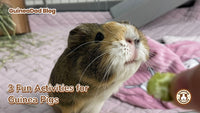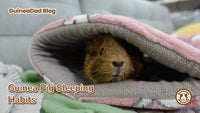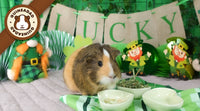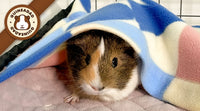Whether you’re a new guinea pig owner or an experienced one, there are some things that you should know about creating the ideal guinea pig cage. This isn’t just for the sake of having a good cage! Ensuring that your guinea pig has a clean, safe, and spacious living space is one of the best ways that you can make sure that your guinea pig is healthy and comfortable, and we’d even go as far as to say that a perfect living environment can extend a guinea pig’s life span.
There are several elements that make up the best guinea pig cage set up, so we’ll go through each component to ensure we’ve got you covered!
The guinea pig cage
When it comes to the cage itself, there are several things to keep in mind. First, you need to take note of how many guinea pigs you have. This is the most basic part of having the perfect cage—it’s important that you choose an appropriately sized cage that is proportionate to the number of guinea pigs you have.
The Humane Society has some approximate measurements for different guinea pig cages that are ideal for each number of guinea pigs that you may own. They’re as follows:
- One guinea pig: 7.5 square feet is ideal, but it’s important to note that guinea pigs are herd animals and need to live in groups, and at the very least pairs, in order to thrive and live happily. This means you should have two guinea pigs.
- Two guinea pigs: 10.5 square feet is the minimum that two guinea pigs need, but there is no such thing as too much space when it comes to guinea pigs.
- Three guinea pigs: 13 square feet is the minimum for three guinea pigs, but the more space, the better.
- Four guinea pigs: 16 square feet is the minimum for four guinea pigs, but more is always better.
It’s important to remember that guinea pigs need all this space so they can stay active and properly exercise. A large space for them to properly exercise is the most basic way to ensure that your guinea pigs are stimulated—constant stimulation is a key to making sure that your guinea pig stays healthy. We recommend adding toys and other things to keep your guinea pigs occupied.
You can even make your cage multi-storied in order to add some variation and vertical space—this can help if you live in a small space where you can’t extend your cage further outwards. You can make these other levels accessible by utilizing short ramps that aren’t too difficult for your guinea pig to travel on.
If your guinea pig is bored and their cage lacks stimulation, this will cause them to become depressed, which can significantly reduce their life expectancy, especially if they don’t have piggy companions. More physical activity can help reduce the chances of the development of heart disease, diabetes, bumblefoot, and other health issues.
Even with plenty of cage space, it’s still vital to give your guinea pigs floor time outside of the care to run around and explore your home in a supervised manner. Similar to baby-proofing a home for a toddler, you should do the same for your guinea pigs.
The Offbeat Piggy Condo Guinea Pig C&C Cage was designed with guinea pig safety and comfort completely in mind. We wanted to make sure that its durability is unmatched—our cage is powder coated, which means that your guinea pig cage will last even longer and your piggy doesn’t come into contact with unsafe materials like they do with less durable cages.
We’ve also made sure that your cage is non-slip and shock absorbing. These are two very important features of the cage—you know that guinea pigs are skittish, anxious animals that scare pretty easily. Even one gentle bump on their enclosure can startle them and send them scuttling into a corner to hide.
When we were designing this cage, it was important to us that we made sure the cage would stay put, as well as absorb any of the impact from any accidental jostling. We even include zip ties for your to secure the cage walls to nearby objects for added stability.
We also made sure that the cage was easy to assemble. We know that putting things together can be pretty frustrating, but we wanted to make this easy on you so you could spend less time assembling and more time bonding with your guinea pigs.

Guinea pig bedding options
Bedding is extremely important when it comes to guinea pig cages. Clean, effective bedding is one of the easiest ways that you can extend your guinea pig’s lifespan. How can bedding extend your guinea pig’s life? By reducing the amount of bacteria that they are exposed to, by eliminating bacterial growth, you’re able to dramatically reduce the chances of your guinea pig developing infections, whether they’re respiratory infections, fungal infections, or otherwise.
There are different types of bedding for guinea pigs, but most are ineffective. The most important features of the best guinea pig bedding is high absorbency, fast-drying, odor elimination, and cushioning, as well as being non-toxic.
Unfortunately, not all bedding checks off all of these things, which can make them not only ineffective, but unsafe for guinea pigs. In particular, paper bedding and wood shavings are not recommended for use as bedding. In particular, we advise steering clear of cedar and pine shavings—both have chemicals in them that irritate guinea pig respiratory tracts and feet, especially when they’re soiled with urine. Paper bedding isn’t nearly absorbent enough, and they do nothing about any odor that might appear.
The best bedding that you can use for your guinea pigs is something that is reusable and washable. These are key features of guinea pig bedding that you should look for because they’re not only better for your guinea pig, but they’re easier and more convenient for you to clean weekly.
Fleece is the best option, but it can’t just be any old fleece that you can buy by the yard at a fabric store! The GuineaDad Liner and GuineaDad Premium Liner are the best options for fleece guinea pig cage liners. They’re not only ultra-absorbent and quick-drying, but they’re also super sanitary. The fleece is made with fibers coated in antibacterial agents that help not only inhibit the growth of bacteria, but also get rid of the odor that comes from the presence of bacteria.
Because urine is quickly absorbed into the absorbent layer beneath the surface fleece, your piggy will never walk around in their own pee, and track bacteria around their cage. The liner is stitched with a quilted diamond pattern, which makes it easy to spot clean.
We recommend spot cleaning your cage daily for dust, poop, stray hay and other foreign debris. We use a small hand vacuum, which helps quickly suck up the mess and makes cleaning so much easier.
By spot cleaning you’re also reducing the amount of mess that you have to clean later during your actual cleaning day! The liner is also washable and reusable, and will last years as long as you take good care of it and follow the care instructions.
Guinea pig cage placement
Location of the cage is more important than you think! Keep in mind that your guinea pigs will be sensitive to sound and are pretty easily frightened overall. This is why it’s important to think carefully about where you’re going to keep their cage.
Temperature is important! The ideal temperature for guinea pigs and what is safe and comfortable for them is anywhere from 65 to 75 degrees Fahrenheit (18 to 23 Celcius). The cage should be located away from areas that receive direct sunlight and any other heat sources, as well as areas that have direct contact with drafts or cold air in general. Of course, ventilation is important, but drafts can be harmful!
Make sure that the cage isn’t located in an area with too much noise. Living rooms would be fine, but away from things like speakers or a TV would be best. This way they don’t get startled by loud noises. The living room would be great in general because they benefit from being around you and whoever else is in the home. Contact with their piggy companions is great, but so is contact with you!
Other things to consider
Another part of a great guinea pig cage setup is the way you place their foods. We recommend placing your hay around in different spots, as this can encourage your guinea pigs to be active and travel around their cage to get to their food. If you place them near their favorite hiding spots, this can make it more appealing for them to run from hiding spot to hiding spot.
Remember that hiding is a big part of guinea pig behavior, and it’s important to accommodate that! Include hideys and tunnels for them to utilize, and even the GuineaDad Liners we mentioned before have a pocket for guinea pigs to tuck themselves away into! You can even stick a hidey or a tunnel into the pocket for extra fun!
While guinea pigs can be housed both indoors and outdoors depending on different factors about where you live, keeping your guinea pigs indoors is the best for them and for you! You’re able to keep an eye on them, as well as bond with them in ways that you wouldn’t be able to if they’re outdoors.
Also, because they’re in your home, you’re able to stay vigilant and observant about your guinea pigs and their health condition. You’re able to identify any changes as soon as they occur, and are able to consult your veterinarian in order to get them the help and treatment that they need right away.
A safe cage is #1 priority
In order to keep your guinea pigs not only happy and healthy, it’s even more important to make sure they’re safe. That’s where you can ensure that your guinea pigs are able to live their longest and fullest lives.
Make sure you choose a safe and large cage, effective and healthy bedding, and place it in a safe spot that is comfortable for your guinea pigs.









1 comment
Do you know when your cages will be back in stock?